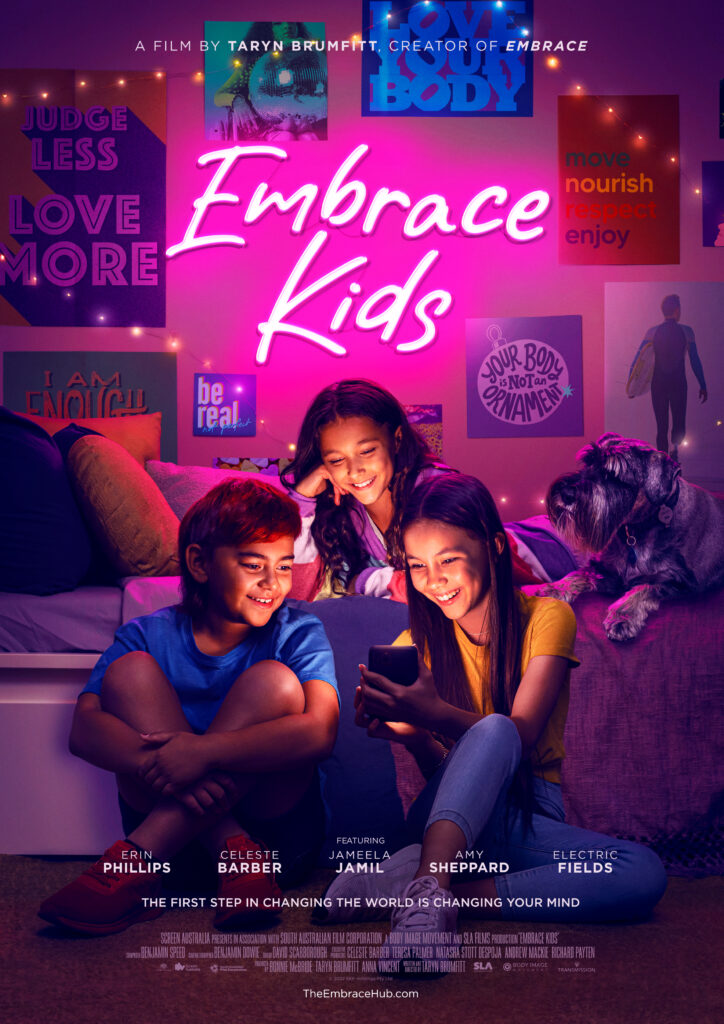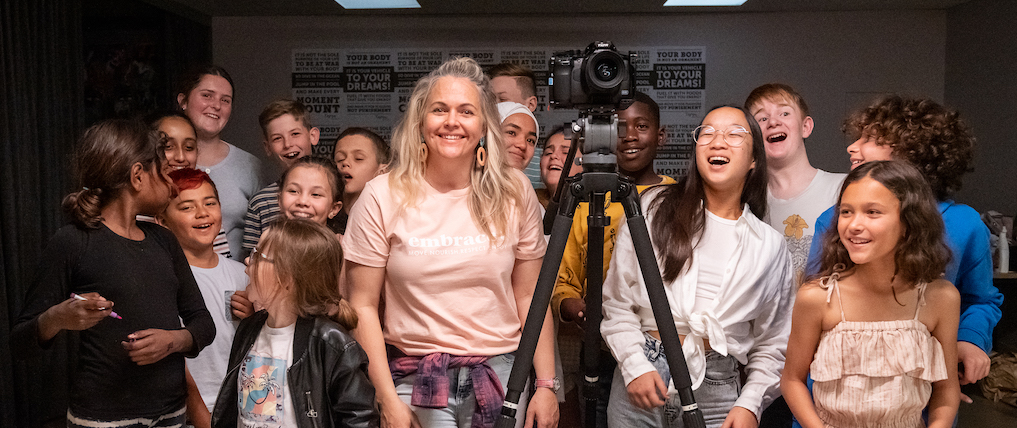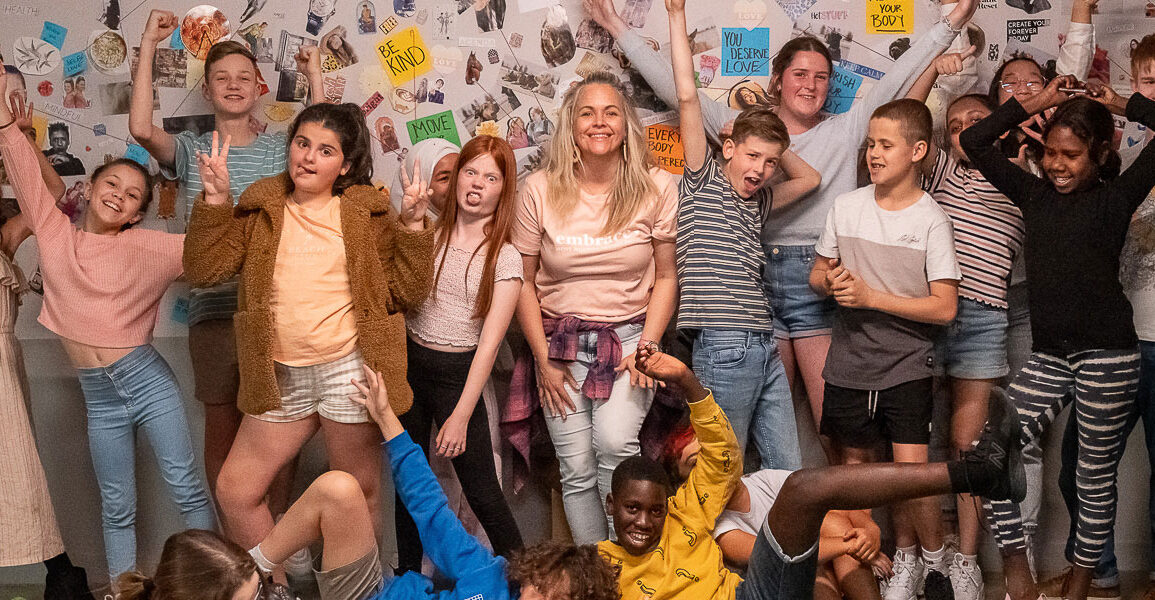Taryn Brumfitt’s 2016 documentary Embrace helped show women of the world the way to embrace a body-positive message, and with the utterly essential 2022 documentary Embrace Kids, she takes that same message to the kids of the world. With a blend of interviews, animation, dogs, music, and a whole lot of dancing, Taryn engages with a bunch of great minds who know a thing or two about body positivity, including Celeste Barber, Electric Fields, Jameela Jamil, Audrey Mason-Hyde, and her trusty schnauzer Chico.
In this interview, Taryn talks about the importance of celebrating body-positivity, how it feels to dance, reassessing who you follow on social media, and why dogs were chosen for the utterly joyous animated sequences in the film. As I mention, Embrace Kids is the kind of film that I wish I had growing up, and for many viewers they may feel the same. With that in mind, this is a really important film to take kids along to so they can hear from folks their own age about what body-positivity means to them.
Embrace Kids is in cinemas now.
(Oh, and make sure to follow Enzo on YouTube too.)
Thank you so much for your time and joining me to be able to discuss it Embrace Kids, I really appreciate it. I loved Embrace, and I loved Embrace Kids too. It’s everything that we need right now. Congratulations.
Taryn Brumfitt: Thank you. It’s that part of the film release where you’re sort of buckling up for it to begin. And so you’re hanging off anyone who’s reviewing the film. Because you’re like, is the film okay? Because you don’t know. It’s your job. It’s your baby, isn’t it? You’re way too close to know. But that’s really lovely. So thanks for the positive feedback.
One of my friends on Facebook was talking reading the Harry Potter books for their kid. And at the moment, they’re going through a chapter which Dudley’s in a lot. And Dudley is described in a lot of ways with [the word] fat being the preface for what [kind of person] he is. And they were talking about, “Do I, as a parent, omit that word, even though it’s on the written page? Do I omit and remove that from the text because of what it’s going to do to my child’s mind?” And the discussion has been quite interesting. But my frame of mind after watching this, I’m like, “Yes, remove it. It doesn’t matter.”
TB: Exactly. It’s a really interesting word, because a lot of the fat activists are trying to take back the power of that word, and not have any shame related to it. But then there’s parents who are like, “I want to do the right thing, but I don’t know what to do.” It’s a big thing for lots of us to go through this with our kids. And I guess that’s the hope of this film, is that parents will see it and kind of just be able to have a really open dialogue about some of these things that come up. This is my new thing being a parent myself, that we shouldn’t have all the answers. Sometimes we can explore with our kids by just asking lots of questions and having these lighter conversations about big heavy subjects that we kind of end up where we need to be anyway. Just kind of heading out into the world with, “I’m just going to be really open to all the possibilities. I’m not going to have any judgment. I’m just going to listen.” I think that’s sort of what’s happening in the world, which is really important.

That’s the thing – getting to hear all the kids talk about in the film – from an adult perspective, we often forget that kids are very intelligent and know what’s going on. They’re very perceptive. So just engaging in a discussion with them about their life, about their body image about those kinds of things, opens up a wealth of discussion for them. It’s very empowering. Is that the core mentality of Embrace HQ?
TB: In the film, we had these extraordinary 18 kids who – oh my gosh – I have to say that they made me want to be a better person and a better human being, because I just feel like they were 1000 times more intelligent and articulate than I was at their age. We never really wanted to sit down with the audience and say, “This is the problem. This is how we can fix it.” We just wanted to showcase lots of people’s stories and open up a new narrative and really cover off some big subjects in that as well: gender stereotyping, disability, inclusivity, representation. There’s so much in this film, it was always the hope that it would just open up a space for conversations.
What changed in the conversation since making Embrace and now Embrace Kids?
TB: We were probably more focused in Embrace on the lack of diversity on the runway or models or the photoshopping. Now, it’s kind of changed to filters, and we talked about social media more. We’ve come leaps and bounds. I’ve been doing this work for 10 years now, and I had to explain to people in the beginning “Body image is…”, no one was really talking about it. And now we are talking about it.
I think the ‘why’ behind Embrace Kids is because after the first film, the number one piece of feedback I had from people who had seen it was, “I wish I had seen this when I was younger.” And so I think there’s been a lot of regret from adults who have wasted so many years of their life hating their body, or having just a dysfunctional relationship with their body. And they don’t want that for our kids. I kind of feel that in this body image movement, and all the things that we’ve been doing, the time is really right now for us, as adults, to take our kids along to see this film [and] to open up the conversation, but also start taking responsibility for the things that we say and do in the world.
You know, don’t go for a run because you ate the chocolate cake because you’re punishing yourself. We need to role model positive body image behaviour for our kids. Don’t talk about diets and scales and don’t talk badly about your body. That’s the number one thing that we can do. And I address to the audience in the film, “Here’s one for you parents, enough! Kids are listening, they’re sponges, and they deserve more from us, they deserve better, they’ve got enough to worry about in the world.”
That’s the one of the things that I was really moved by, this is the kind of film that I wish I personally had as a kid, because I had body issues as a kid. And it’s only been in the past couple of years that I’ve received a diagnosis for an autoimmune disease, so I have an invisible disability, which has coloured how and why I wasn’t able to look like the kids growing up, I wasn’t able to play sports, I would get fatigued very easily. And so seeing the toys that have these very muscular characters, it just took me back to childhood where He-Man was the big thing, and it’s like, I’m never gonna be like He-Man. I remember being a kid and just feeling terrible because the expectation in a kid’s mind that as an adult I’m going to be turning out like that in 10 years-time. It’s very emotional to be able to hear that, and I imagine for a lot of kids, it’s going to be very important and powerful for them too.
TB: I think it feels good to be seeing that. That’s why having such a diverse range of people in the film, sharing their stories the way they did with such vulnerability and openness, and beauty – everyone who’s in that film, I still tear up when I watch some of the interviews because they just exude this beauty. But they’ve all been through their own journeys of the struggle with being at peace with who they are.
And I guess a great hope for this film is that we don’t have to be fixing problems later on in life. What if we got in early, and kids just didn’t even know that it wasn’t a problem to look like the person on social media or on the billboard or [in] movies? What if we all just grew up and went “I am me. I’m excellent. Let’s get on with life.” I mean, gosh, I’d love to put myself out of a job. That’s my goal.
Have there been people that you spoke to 10 years ago come back to you and talk about the impact of what you’re doing for them?
TB: Oh, it’s probably the best part of my job, I have to say. We have over half a million followers on social media, the first film was seen by millions of people in over 190 countries, so there has been – and still is to this day – daily messages and emails from people about how the storytelling that we’ve done has impacted their life. And it’s a beautiful thing.
It’s funny, when I’m in the US and I get interviewed, whether it’s Good Morning America, or The Doctors, there’s always this question of “How do you feel trying to lead a global movement of change? Aren’t you overwhelmed?” And in a very non-cocky way, I have to say, not at all, because I’ve never met a person who’s learned to embrace their body and regretted the decision to do so.
I think there’s a real shift around the world, we’re all going “Okay. It didn’t feel so good to hate my cellulite or my jiggly bits, or what I didn’t have or what I do have, I’m just going to make peace with this and get on with it.” And I think reading those stories of change in people in, whether it’s Spain or Venezuela or the Ukraine or the UK, you name it, it’s the best thing ever to positively impact someone’s life. And that’s not just me, that’s all the people that put themselves forward to be on the big screen and share their stories which they did in Embrace and again in Embrace Kids.
What discussions did you have with the kids when they were cast?
TB: We wanted to make sure that we had children who were very comfortable to be around the chaos of the set. And that’s what Embrace Kids was. I mean, we had 18 kids, about 22 crew, we had Chico the schnauzer running in and out; it was hectic. Really, it was just, “We’ve got some issues around body image, we’re going to put you in a room, and you guys are going to do some workshops and work out what the problems are. Who are good people to interview? You’re going to interview some of them, and you’re going to come up with some solutions. And then you’re going to share what you’ve learned in this experience.”
The kids, I just adore them. They’re so beautiful on the screen, and so vulnerable and just so real. I think it’s going to be a really great. Enzo is everyone’s favourite, he’s like “I love my body. And I love who I am.” And we just want to make him the biggest YouTube star in the world. When you see the film, everybody will know exactly who I’m talking about. This kid is fun, and he’s dynamic, and he’s got his own story to tell.
As soon as the film finished, I went over and subscribed to his YouTube channel. And I watched a few of his videos yesterday, and there’s one that’s like, “How do you eat Vegemite?” And it’s like, “You go to the store. You eat Vegemite. Oh, no, I’ve been in the store too long. And then you get swallowed by all these Vegemite monsters.” It’s just the most bizarre, entertaining thing.
TB: I just love it. When I watched some of his YouTube [videos], I was like, “What am I watching?” It’s just his energy that he brings to the screen that I enjoy.
I want to talk about the power of dance, the importance of dance and embracing and connecting with your body through dance. How important is it for you to dance? And how important is it to dance with other people?
TB: I love dancing. I love dancing on my own. I love dancing with people. If there’s music, I’m on the dance floor. We all want to dance. We all want to move our bodies. But sometimes our brains get in the way. If you hear music, and [no one’s on the] dance floor everyone’s like, “Someone go first!” and then everyone swarms. I just think it’s a really joyous way to feel into your body. We touched on that in the film as well. Electric Fields did such a great job, I think it was Michael who said, “Just dance!”, and then we see the kids dancing. I think for me it’s probably the most connected I am with my body when I dance.
What does it do to your mind? Like? Are you consciously thinking about being connected with your body when you’re dancing?
TB: It’s just being free. In fact, in LA a few years ago, I was watching this busker play and I watched this Asian woman, she looked about 80, she started dancing near the busker, and I observed some people who were laughing at her dancing. And I’m like, “No, you guys, you’re the fools. She’s the one with all the freedom and the joy. And she’s just living and being present and being immersed in music and sound and dancing.” And I think that we all need to remember to enjoy our bodies. And I haven’t met anyone is like “No, no, I don’t like music.”
I think there’s this permission that we need to give ourselves just to tap into that, and I think we’ve tapped into our hatred for our body for so long, and it’s become very natural to us. And I guess that’s because we live in a world that tells us to not be comfortable in the skin we’re in. For a long time marketing and advertising has centred around making us feel bad. And we’ve bought into it. And now I think we’ve had enough.



The one of the things that surprised me the most was the discussion about social media and the impact that social media has on people and the images that we see. It’s just part of our lives, we wake up and the first thing a lot of us do is pick up our phone and look at Facebook or Twitter or Instagram and then there’s that feeling of inadequacy. Was that a bit of a surprise for you about the impact of social media on everybody around the world?
TB: I don’t know to be honest whether it was a surprise. I certainly knew it was a contributor to how people were feeling about their bodies. I guess what we wanted to do very delicately in Embrace Kids is not say “Don’t go on social media.” We just wanted to highlight that social media can be a really fun place to hang out. Not all the time, as Electric Field say, “Get out in life and do all the things and have the adventures”. We are using social media, it’s here to stay. So why don’t we use it in a way that makes us feel good about who we are?
And it’s something I actually do in schools, I ask people “Show me your phones. Who are you following on social media?” And we have a little scroll through, and I ask them “Why are you following this person? What does this person do for you? Does this person make you feel good?” And some of the answers I don’t need to say anymore, because the self-reflection of why they’ve chosen to follow those people kicks in. And I think that’s what I want all kids and all people to know is that we have the power, we have control about who we let into our lives. We wouldn’t let someone nasty into our circle of friends who’s like “You need to change. You need to lose weight. You need to not have these lines on your face.” We wouldn’t allow it. So why do we allow on our phones?
All the research is coming in now. We know that as little as seven minutes on Instagram can make you feel dissatisfied and depressed about your body. That’s if you’re looking at appearance-based images and people’s bodies. And what we’re all encouraging from the team here is get people to look at cat videos or dog videos or crafts or projects as opposed to what people look like. Because the least important thing is how someone looks and the most interesting thing is what they do.
Talking about Chico the schnauzer, he’s around and about and part of the lives of the kids and part of Embrace HQ. Schnauzers faces are very expressive, they’ve got their beard, the big eyebrows and the big eyes. Does that expressive quality play into making kids feel comfortable there?
TB: The reason why Chico and the dog thing even existed in the film was we were trying to find solutions to some of the challenges which was, we can’t set up the problem in the way that I did in Embrace. I showed everything that was the problem, and we all went “Oh, there’s our problem,” and then we went out into the world and we solved it, and the narrative and the arc and the filmmaking process was taken care of.
With this film, I couldn’t, as a director show kids an image of a stereotypical body, because I know through having worked with Dr Zali Yager on the project that any child who sees that image, it’s going to do them even more damage, we can’t show that problem. And this was the intersection of science and creativity.
Dr Zali Yager is brilliant. She’s written 50 published papers and books. And she was an associate professor at Victoria University. I engaged her on this project to ensure that what we were showing kids was safe and effective. You could imagine in the filmmaking process, at times, the creative team, and Dr Zali’s team, we all love each other, we all work well together, but it was like, “How are we gonna do this?”
Insert dogs.
Dogs come in all different shapes and sizes. And we don’t say to a sausage dog, “You should look like a cattle dog”, or we don’t say to the Bulldog, “You should look like a chihuahua”. We just accept them as they are. And we love them for all of their uniqueness. So that’s kind of where it came about in the film with having these dogs. And then the animation, I think is just fun. We invested quite a bit of money and time in getting those animations right. And the team here at Monkeystack, they just did such a great job. From where Chico started to where he is in the film, it’s like “It’s Chico!” And he follows me around everywhere Chico, so he just needed to be in the film.
As a director working in Australia today, what does that mean to be working in Australia right now? How does the Australian identity play into your role as a director when you’re telling these stories on film?
TB: What I love about directing both of these films out of Australia, and in particular out of Adelaide, I work at the South Australian Film Corporation, I work at Adelaide studios, I was new to filmmaking in 2016. Embrace was my first film. And I think I just completely underestimated the brilliant people that are here and that we can tap into. And I think for me it’s really important as the director, I’m always the one with the microphone or doing the interviews, I just find the filmmaking process and how collaborative it is, and how many geniuses there are behind the scenes that we don’t even hear about. Like the editor of Embrace Kids, David Scarborough, if I saw him in the halls here, I’d bow to him. He’s incredible at what he does.
I’m looking forward to making more films out of Aus. Embrace Men is next. It’s been bubbling away for a couple of years now. So that’s kind of where I’ll be heading next. And then after that, who knows? But I’ve stumbled into filmmaking, and I’m never leaving. It’s great.
Can I just leave this interview just on one note, which is really important to me? Of course, Embrace Kids is not a Marvel film, but I think it’s the most important film that parents, grandparents, carers or teachers could take their kids to see this year. We opened Embrace on 13 screens. We’re opening Embrace Kids on 81. We’ve had so much support from the cinemas, and I would just love to encourage everyone to go and see this film. It’s just so important. I’m so passionate about this subject. We could really fix this and get on the right track if we all get on the same page. And that is experiencing this film in a cinema. So please support me.



